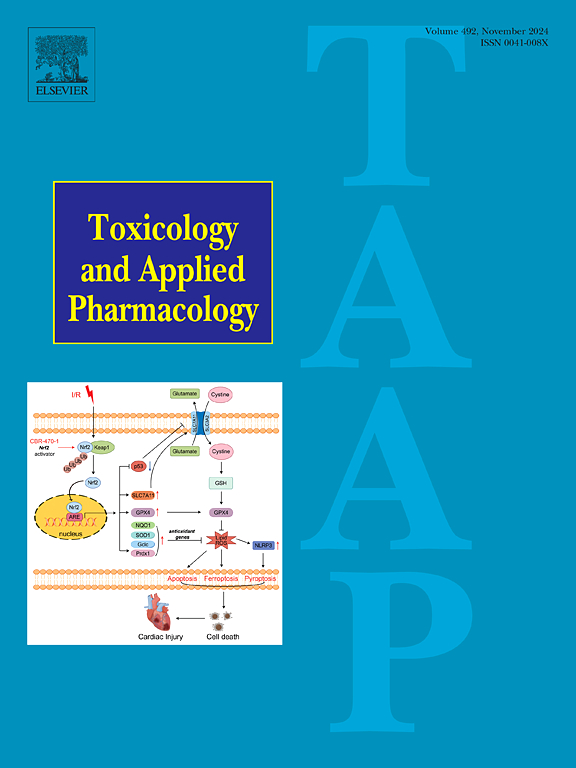Carvacrol通过nlrp3介导的焦亡和mTOR/Nrf2/ ppar γ依赖的自噬信号通路减轻心肌梗死。
IF 3.3
3区 医学
Q2 PHARMACOLOGY & PHARMACY
引用次数: 0
摘要
心肌缺血,也称为心肌梗死或心脏病发作,是一个重大的全球健康问题,也是世界范围内死亡的主要原因。本研究的重点是研究香芹酚在三个特定途径中的心脏保护作用:核因子e2相关因子(Nrf2) /过氧化物酶体增殖物激活受体因子(PPARγ)偶联抗炎反应,炎症小体(NLRP3)介导的焦亡,以及哺乳动物雷帕霉素(mTOR)依赖性自噬信号的靶标。将雄性Sprague Dawley大鼠分为3个实验队列,确定卡伐克罗的最佳剂量(20 mg / kg、50 mg / kg和80 mg/ kg)和最佳给药策略。我们的研究结果表明,异丙肾上腺素增加ROS的产生,诱导nlrp3介导的焦亡,并调节mtor相关的信号级联。carvacrol治疗激活Nrf2 / HO-1和PI3K / AKT信号通路,导致NLRP3炎性体逆转。此外,Nrf2抑制剂全反式维甲酸(ATRA)拮抗卡伐克罗的保护作用,并通过诱导炎症介质加重心肌梗死。综上所述,我们的研究结果表明,香芹酚减轻异丙肾上腺素诱导的心肌缺血,部分是通过激活Nrf2和PPARγ以及下调NLRP3。本文章由计算机程序翻译,如有差异,请以英文原文为准。
Carvacrol attenuated myocardial infarction through NLRP3-mediated pyroptosis and mTOR/Nrf2/PPARγ-dependent autophagic signaling
Myocardial ischemia, also known as myocardial infarction or heart attack, is a significant global health issue and a leading cause of mortality worldwide. The present study focuses on investigating the cardioprotective role of carvacrol on three specific pathways: nuclear factor E2-related factor (Nrf2) / peroxisome proliferator-activated receptor factor (PPARγ)-coupled anti-inflammatory response, inflammasome (NLRP3)-mediated pyroptosis, and mammalian target of rapamycin (mTOR)-dependent autophagic signaling. Male Sprague Dawley rats were divided into three experimental cohorts to determine the best dose for carvacrol (20 mg / kg, 50 mg / kg, and 80 mg/ kg) and the optimum treatment strategy. Our findings showed that isoproterenol raised the production of ROS, induced NLRP3-mediated pyroptosis, and modulated the mTOR-linked signaling cascade. Treatment with carvacrol activated the Nrf2 / HO-1 and PI3K / AKT signaling pathways that led to the reversal of NLRP3 inflammasome. Moreover, the Nrf2 inhibitor all-trans-retinoic acid (ATRA) antagonizes the protective effects of carvacrol and exacerbates myocardial infarction by inducing inflammatory mediators. Taken together, our findings suggest that carvacrol mitigated isoproterenol-induced myocardial ischemia, partially through the activation of Nrf2 and PPARγ and downregulation of NLRP3.
求助全文
通过发布文献求助,成功后即可免费获取论文全文。
去求助
来源期刊
CiteScore
6.80
自引率
2.60%
发文量
309
审稿时长
32 days
期刊介绍:
Toxicology and Applied Pharmacology publishes original scientific research of relevance to animals or humans pertaining to the action of chemicals, drugs, or chemically-defined natural products.
Regular articles address mechanistic approaches to physiological, pharmacologic, biochemical, cellular, or molecular understanding of toxicologic/pathologic lesions and to methods used to describe these responses. Safety Science articles address outstanding state-of-the-art preclinical and human translational characterization of drug and chemical safety employing cutting-edge science. Highly significant Regulatory Safety Science articles will also be considered in this category. Papers concerned with alternatives to the use of experimental animals are encouraged.
Short articles report on high impact studies of broad interest to readers of TAAP that would benefit from rapid publication. These articles should contain no more than a combined total of four figures and tables. Authors should include in their cover letter the justification for consideration of their manuscript as a short article.

 求助内容:
求助内容: 应助结果提醒方式:
应助结果提醒方式:


